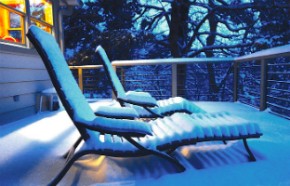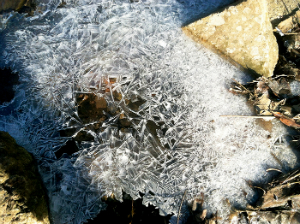Not yet spring: Notes from the farm

A movement catches the corner of my eye just before dark on an early February evening. I glance up from my seed and fruit tree catalogs to see the silhouette of an owl in flight—steady, silent, strong.
I forget to breathe for a moment as he glides low and slow, barely five feet off the snow-covered ground. One effortlessly buoyant wing beat, and he melds into the woods.
Whose woods these are I think I know, for I hear the barred owl call from them each night. The birds are loquacious at this time of year, as males seek their mates and prepare for the spring season of egg laying and owlet feeding.
Although it’s almost dark, I saw brown-gray stripes on the buff background of the three-foot wingspread, confirming that my night visitor is the barred owl who asks each night, from the red cedar outside my bedroom window, “Whooo, whoooo, who cooks for yooooouuu?”
Each time he queries me I answer back, “I do.” I set snap traps for the mice that invade the house each winter, put their soft bodies outside, and within 24 hours they are gone. I like to think I’m feeding the owl, although it could be a raptor, red-tailed or Cooper’s hawk, or just a raccoon, opossum, or even a stray cat. In any case, each time we have our neighborly exchange I find myself wishing such interspecies pleasantries were more common. This is the time for indulging such winter fancies.
Read our latest issue or browse back issues.
I mostly hear complaints about the ice and snow, the slushy corners, the long dark nights, the fact that it is not yet spring. It’s been too long since Christmas and the revelry of New Year’s, and most folks just wish that our midwestern winter were over. But this lingering “not-yet-spring” is a precious time, especially for me, and especially this year.
For the first time in the entire 22 years since my brother Henry started his farm, neither he nor his wife Hiroko will be on the farm. They have left for Japan to take a year’s sabbatical. The word sabbatical comes straight from Shabbat, God’s day of rest after six hard days’ work creating the universe. It also refers to an extended period of leave from one’s work—not so much for rest as for pursuing a specific goal, one impossible to attain while immersed in day-to-day busyness.
The day-to-day, sunup-to-sundown physical labor and mental concentration involved in growing and selling more than 650 varieties of vegetables has certainly been all-consuming. Henry explained his goal for his sabbatical in a letter to his customers:
In a sense, a lack of perspective brought me to farming, and what I love about farming. Farming is a job that you can sink into. As a matter of fact, you have to sink into it. You cannot flit along the surface of farming and be successful at it. It is a full-immersion profession.
That total immersion, the total concentration of mind, body, and soul, the shooting of the rapids that occurs when I launch myself upon the stream of the seasons and allow the current of the universe to pull me from one day to the next to the next—that is the source of the intense joy I gain from farming.
But there is a downside to this immersion life, to living in this eternal cycle of the seasons. And that downside is a loss of perspective. Or rather a loss of the time and distance required to acquire perspective. While what I love about farming is living each moment in time and space, in order to gain perspective one has to step out of time and place.
While Henry begins his year away, these short wintry days of early spring are a mini-sabbatical for me, with time to walk, read, write, daydream, and gain perspective before a new farming season is upon us. This is the calm before the storm of spring farm work. Even in snowy February, Henry’s farm hands are prepping the hoop houses. But for them and for me, this is still mostly a time of rest, a time to revel in the soft stillness of an owl flying or snow falling.
 |
Recently I walked down to the stream that separates the two fertile bottomland fields of Henry’s farm. It was nearly covered in ice, but underneath water and air bubbles rushed along, breaking to the surface and flowing brightly and swiftly over rocky rills framed by ice crystals that flashed like fire. My thoughts carried me to the words attributed to Fra Giovanni Giocondo, a brilliant artist, architect, and writer from 15th-century Verona: “There is radiance and glory in the darkness, could we but see, and to see, we have only to look.”
Long, dark winter nights have their bright side—figuratively, in the quiet time they provide, and also quite literally. The past few nights have been spectacular for moon gazing, and for soaking up the softly sparkling stillness. Each night three luminaries have risen in the east—the blazing planet Jupiter above the moon, and alongside, Regulus, the brightest star in the constellation Leo. Their combined light, reflected off the bright snow, brings a glorious radiance to the darkness.
But Giocondo’s sentence is also metaphorical. Even when we are in dark despair, there are flickers of light if our eyes and hearts are open. The light may come from celestial bodies, from water flowing under ice, or from a silent ghost of the bird world floating by with supernatural grace.
Spring will come, and with it hundreds of thousands of seeds to plant, and tens of thousands of transplants, and endless mulching, weeding, trellising, and all the other tasks that bring good food to the table. Soon my eyes will be turned to the earth below much more often than to the skies above.
I return to my seed catalogs and my fruit tree fantasies. It’s dark, so I listen to what my eyes can’t see: icicles and water, old differences dissolved, dripping down to earth together. Occasionally mini-avalanches of snow fall softly from my roof. They will soon melt onto patio stones and make their way into the garden where strawberry plant roots will drink water as they green, blossom, and bear fruit come June.






